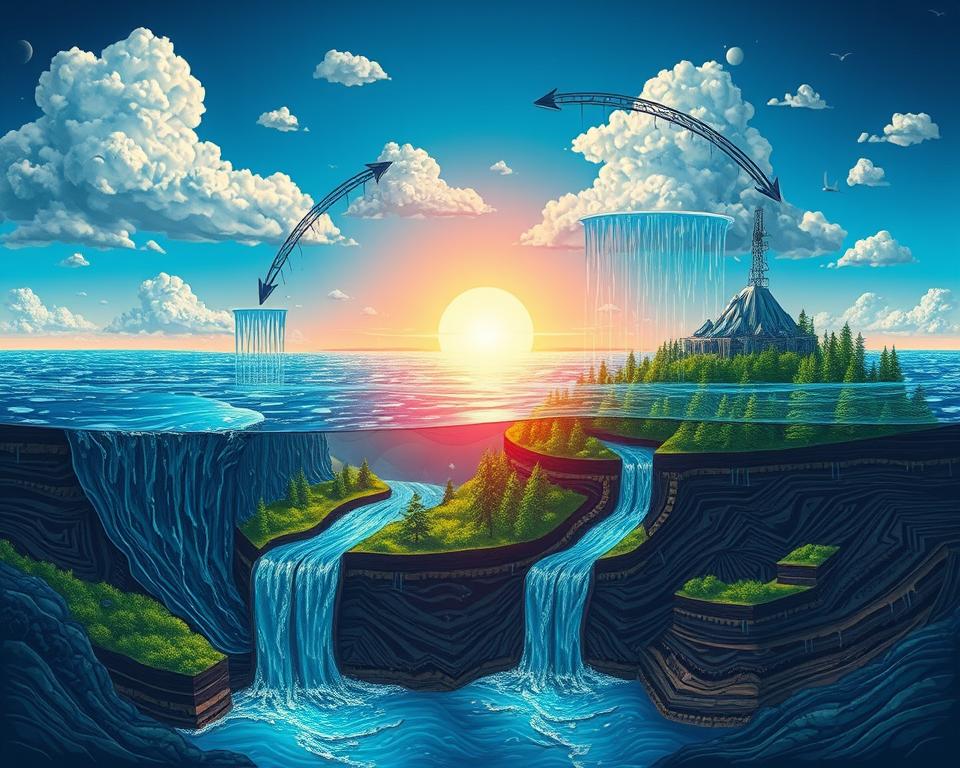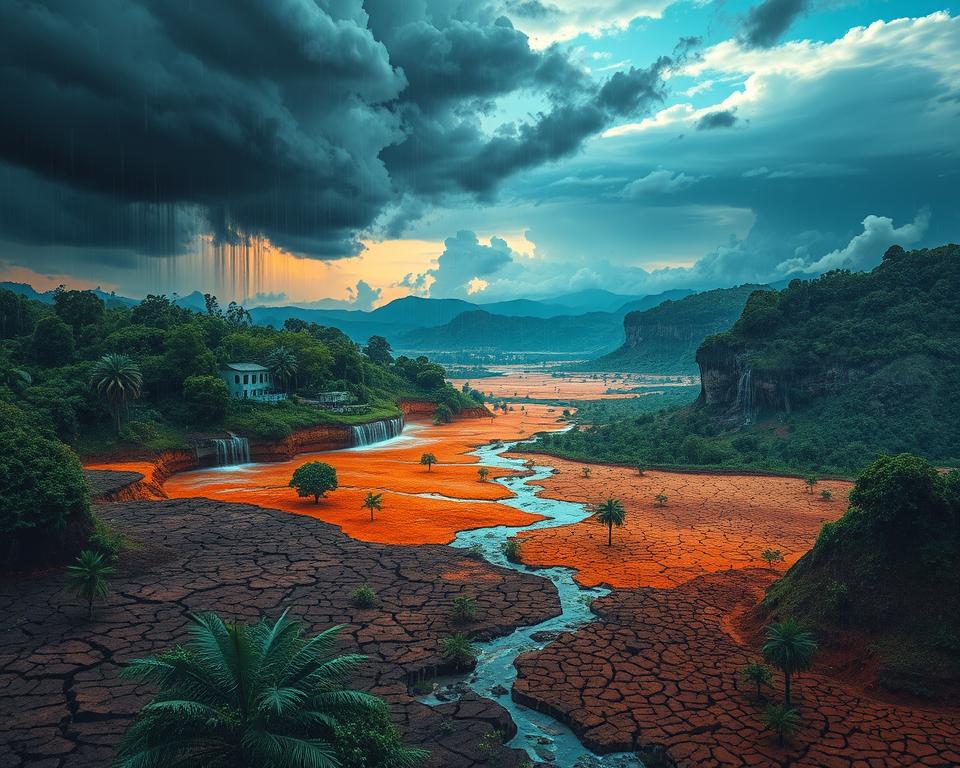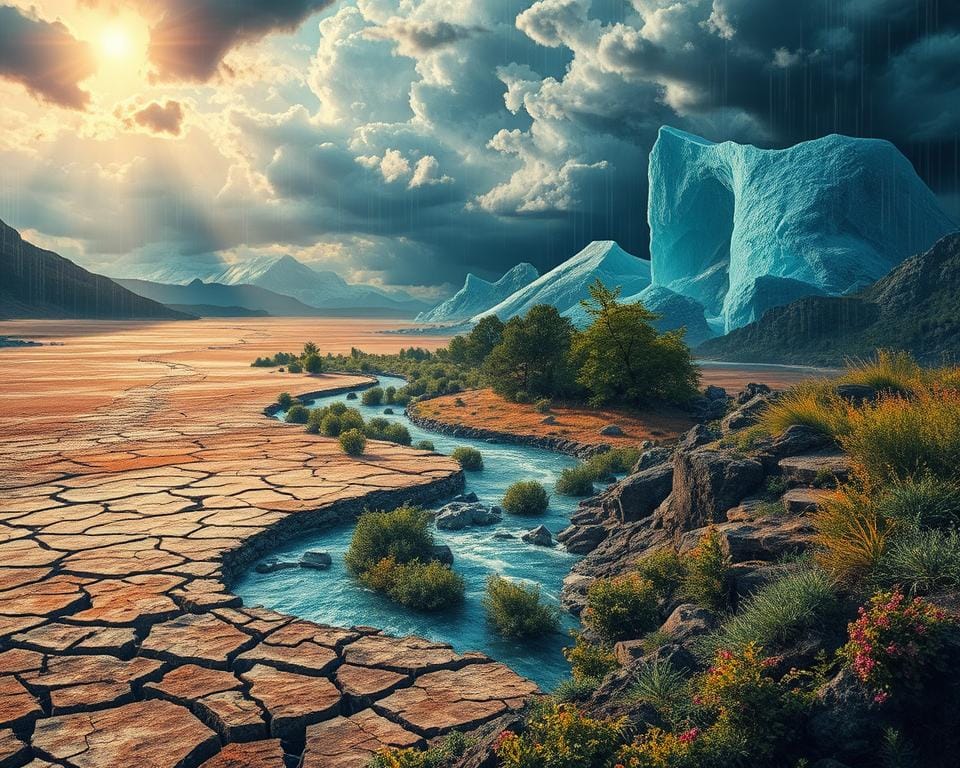Climate change is hitting our planet’s water cycle hard. We see this in extreme weather patterns in the U.S. and worldwide. The way water moves around our planet is changing a lot. This leads to less water in some places and too much in others, causing floods.
Reports from the IPCC AR5 show a significant rise in water vapor, by 3.5% over 40 years. This matches a temperature increase of 0.5°C. Also, in 2023, the World Meteorological Organization noticed more intense droughts and heavy rainfall, upsetting the water cycle even more.
Last year, the world lost over 600 gigatons of water from its glaciers. This vast change affects everything – from oceans to rivers to the air we breathe. Almost 3 billion people are at risk because of these shifts. Food production could drop, hurting the poorest countries the most by 2050.
Learn more about these critical changes by reading this detailed article. Let’s explore the water cycle’s basics and how climate change is reshaping its core workings.
The Fundamentals of the Water Cycle
The water cycle involves moving water across Earth. It changes water from solid to liquid to gas. The sun’s energy drives this cycle, giving it the name solar-powered water cycle. Understanding it helps us learn about our water resources and their relationship with the environment.
Overview of the Water Cycle
The water cycle connects glaciers, oceans, and the air. It includes evaporation, condensation, precipitation, and collection. Water from oceans and rivers evaporates due to the temperature influence on evaporation.
It then condenses into clouds and falls as rain or snow. This water returns to bodies of water, completing the cycle.

The Role of Temperature and Energy
Temperature and energy greatly affect the water cycle. The Clausius-Clapeyron equation explains how warm air holds more moisture. This changes temperature influence on evaporation and precipitation rates. It can cause more intense weather patterns. The cycle also moves heat via evaporative cooling, affecting climate and ocean currents.
The Water Cycle’s Impact on Climate
The water cycle is crucial to Earth’s climate. It moves heat, affecting temperatures and weather patterns. Greenhouse gases warm the planet, changing the water cycle. This can lead to more extreme weather, like storms and rising sea levels. A stable water cycle is key for a stable climate.
| Statistics | Data |
|---|---|
| People living without safe drinking water | 1 in 3 |
| Child deaths due to polluted water (per 80 seconds) | 1 |
| People without enough water by 2050 | 5.7 billion |
| Lives saved by climate-resilient water supply and sanitation yearly | 360,000 infants |
| Reduction in water stress by limiting global warming to 1.5°C | Up to 50% |
How Climate Change Alters Precipitation Patterns
Changes in precipitation patterns because of climate change are noticeable across the globe. Floods hit areas that rarely saw them before. Meanwhile, regions known for dry weather are changing too. These changes are due to more extreme weather events, a stronger water cycle, and shifts in temps. Let’s look at the key ways climate change affects rainfall and snow.

Increased Frequency and Intensity of Rainfall
Rising temperatures lead to more frequent and stronger rains. Studies show a city might get a month’s rain in just one day. This can cause serious flash floods. Warmer air holds more moisture, which means 7% more water vapor for every degree Celsius the temperature rises. So, we see more intense rain showers.
Extreme rain can quickly lead to flash floods. An example is when Leominster, Massachusetts, got 9.5 inches of rain. It caused chaos and needed costly repairs, from $25 to $40 million. This shows how common such climate-driven floods are becoming. It stresses the need for better water systems nationwide.
Change in Snowfall and Ice Melts
Climate change also messes with snow and ice. Winter storms, like bomb cyclones, hit harder and more often. Glaciers are melting faster, changing snow and ice patterns. This shifts weather patterns too and brings more extreme water levels.
Atmospheric rivers, over 300 miles wide, carry huge amounts of water. They can cause big floods and change regions’ water cycle. Also, rainfall globally has been inching up by 0.04 inches every decade since 1901. This shows the big picture of how rainfall patterns are changing worldwide.
Humans are causing these changes by releasing greenhouse gases and burning fossil fuels. We can reduce the impact by tackling these root problems. Meanwhile, using green solutions like bioswales and living shorelines can help with stormwater floods. They also protect our coastlines from future climate impacts.
To find out more about how new rain patterns can cause emergencies, visit the Understanding No Running Water Situations. This site gives in-depth info.
The Connection Between Climate Change and Drought
Climate change is making droughts worse around the world. Places like the Mississippi, Amazon, Ganges, Brahmaputra, and Mekong rivers are badly hit. They have less water than normal, raising drought risks and making things like soil drying worse.
Regions Most Affected by Drought
The United Nations predicts more heavy rains, droughts, and strong hurricanes. The Amazon rainforest, once lush, is drying up because of heat and tree cutting. This leads to more fires and carbon in the air. It’s bad for wildlife and the climate.
Agricultural Impact and Soil Moisture
Farming suffers when the ground gets too dry. Crops are threatened by too much heat and not enough rain. Since land gets hotter than oceans, droughts get even more severe.
The earth can hold a lot of water, way more than rivers. But this ability is dropping because of intense farming.
Farmers can help by not plowing too much and using cover crops. Good soil care can improve the land’s water management. This helps fight drought’s impact on farming.
Impact on Freshwater Resources
Climate change deeply affects our freshwater, changing how much we have and where it is. Increases in air moisture and changes in rain patterns are causing water distribution issues worldwide. Since the 20th century, human actions have made freshwater even scarcer, affecting around 80% of the global population with water security threats. This issue is made worse by the fact that less than 2% of Earth’s water is freshwater. Only 4% of that is readily available for our use.
Availability and Distribution of Freshwater
Climate change is messing with how much fresh water we can get, leading to more rainfall globally. However, larger areas will face more droughts that are worse than before. Places like the Murray-Darling Basin in Australia have seen a 15% drop in water because of less rain and hotter weather.
In Bangladesh, rising sea levels could flood 20% of the country, affecting its already scarce water resources. At the same time, California in the USA has seen both extreme drought and floods in recent years. If we can limit global warming to 1.5°C instead of 2°C, we could significantly reduce the number of people facing water scarcity.
Contamination of Water Supplies
Water quality is at risk too because of climate change. More extreme weather and longer droughts can lead to more water pollution. Floods wash pollutants into our water, and farming adds to the problem, making water unsafe. Communities increasingly use water sources that are not protected or are very polluted. Efforts like setting up desalination plants and improving water resource management are critical. For example, VA Tech Wabag’s project and discussions at the University of Arizona’s 2024 conference are steps in the right direction.
You can learn more about climate change and water at National Geographic’s education resource or discover the importance of water management at this website.

